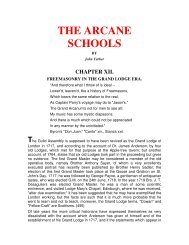Create successful ePaper yourself
Turn your PDF publications into a flip-book with our unique Google optimized e-Paper software.
From the South<br />
Brethren, this month I have chosen to give a brief history<br />
about the <strong>Trestle</strong> <strong>Board</strong> and the origins of the use. I have<br />
utilized material from <strong>The</strong> Masonic Lodge of Education and<br />
<strong>The</strong> Masonic Trowel to assist me with the writing of this<br />
article I hope it is enjoyed by all.<br />
A Masonic trestle board is a design board for the<br />
Master Workman to draw his plans and designs upon to give<br />
the workmen an outline of the work to be performed. In today's<br />
terms, it would be called it a blueprint. It is one of the 3<br />
Movable jewels as is learned in the Entered Apprentice<br />
Degree. A trestle board is a framework consisting of vertical,<br />
slanted supports with one or more horizontal crosspieces on<br />
which to hang or display an item. Today, it is better known<br />
as an "easel". Some jurisdictions around the world call it a<br />
tracing board. <strong>The</strong> "Tracing board" may very well have come<br />
before the use of the word "<strong>Trestle</strong>board" because lodges in<br />
Europe (which pre-date American lodges), use the word<br />
"Tracing <strong>Board</strong>".<br />
When lodge was held in secret areas, once lodge was in<br />
session, the Tyler would draw an oblong rectangular<br />
representation into the dirt that symbolized the form of the<br />
lodge. <strong>The</strong>n onto that tracing board was drawn the<br />
architect's plan, the working tools in the degree that was to<br />
be worked. Through the years, the Masonic Tracing <strong>Board</strong><br />
progressed to charcoal or chalk on the floor of taverns<br />
where lodges were held back in the 1700s. After the lecture<br />
was complete, the Stewards or the Entered Apprentices<br />
would get a mop and bucket and remove all trace of these<br />
drawings, this practice was used as a lesson in secrecy.<br />
This procedure was messy and somewhat uninteresting, so<br />
cloths or rugs were created which could be laid onto the<br />
floor and simply folded up when the lecture was complete.<br />
Later, these cloths were placed onto a table.<br />
News from the East<br />
Hello my Brothers, I would like to thank everyone at our last<br />
meeting for putting on such a nice Degree.<br />
Congratulations to our newest Obligated Brothers. Please<br />
make our new Brothers Tom Anderson, Joe Falzone and Rick<br />
Hanson feel welcome when you see them in Lodge for we are<br />
all family now. Also we are planning a Fellow Craft Degree on<br />
the 21st of June. On that note I would like talk about the<br />
origin of the term Fellow Craft. <strong>The</strong> term ( fellow ) has a long<br />
and distinguished history, most commonly used to denote<br />
that one is of higher status than just being a member of some<br />
organization. One becomes a fellow of research or<br />
educational society, for example by being voted into that<br />
position after having done research and being published.<br />
Members of the teaching staff of a university who are not full<br />
members of the faculty are sometimes called ( teaching<br />
fellows). In the guilds from which we believe Masonry arose a<br />
( Fellow of the Craft ) had roughly the same status as a<br />
journeyman would have today .When Masonry had only one<br />
Degree there was a section known as the (Fellows Part)<br />
which was conferred on those who had shown a mastery of<br />
the material of the Apprentice Degree. Food for thought from<br />
the East. May God bless our lodge and all the service men<br />
and women who keep our country free.<br />
Jim Phillips - W.M:.







